How to Add JavaScript to WordPress Pages and Posts: A Beginner’s Guide

JavaScript is a powerful programming language that allows you to add interactive features to your website. Whether it’s a dynamic calculator, a video player, or an alert box that pops up when a button is clicked, JavaScript helps make your website more engaging and functional. In this comprehensive guide, I’ll walk you through how to add JavaScript to your WordPress pages and posts safely and effectively, covering various methods to suit different needs.

Can You Use JavaScript in WordPress?
Yes, you can use JavaScript in WordPress! JavaScript is commonly used to enhance user experience (UX) and make websites more interactive and responsive. You can use JavaScript to create pop-up alerts, display messages when a user hovers over an element, or even add interactive tools like calculators or custom form validations. While adding JavaScript to WordPress is relatively straightforward, having a basic understanding of HTML and CSS can help you get the most out of it.
Tip: If you’re starting, don’t worry if some terms seem overwhelming. Take it one step at a time, and soon, you’ll be adding JavaScript like a pro!
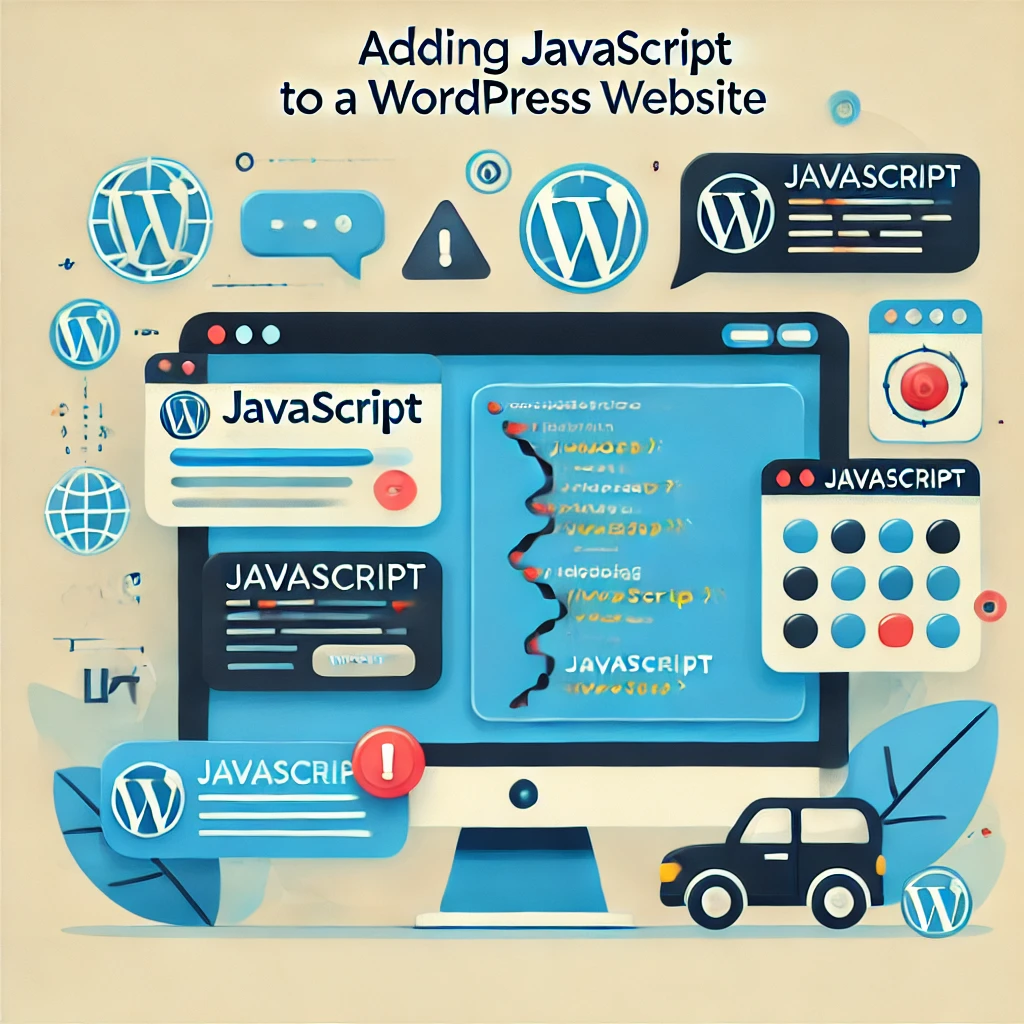
Things to Consider Before Adding JavaScript to WordPress
Before you add JavaScript to your WordPress website, remember a few essential things. JavaScript errors can potentially break your site, so it’s always best to proceed with caution and follow these steps:
- Backup Your Site: Always have a recent site backup before adding any custom code. This includes the database (which stores your posts, pages, settings, and configuration) and the files (like images, themes, and plugins). Plugins like Jetpack or manual backups can help you safeguard your work.
- Personal Note: I can’t tell you how many times a backup has saved me! It’s one of those things you wish you had done before something went wrong.
- Use a Child Theme: A child theme is a copy of your current theme that allows you to customize it without affecting the original code. If you make changes to the main theme files, they could be overwritten the next time your theme updates. Using a child theme will also make your modifications easier to manage.
- Testing Environment: Create a testing environment where you can add JavaScript code without risking breaking your live website. Services like Local by Flywheel or a staging site can help you test changes safely.
- Quick Tip: A testing environment is your best friend. It lets you experiment without risk to your site, so you can make mistakes and learn freely.

Methods to Add JavaScript to WordPress
There are several methods to add JavaScript to WordPress, and I’ll cover the most effective ones here. You can choose the method that best suits your specific needs.
Method 1: Using Plugins
If you’re not comfortable writing code or just want a simpler solution, adding JavaScript to your WordPress site using a plugin is the easiest option.
- Insert Headers and Footers Plugin: This plugin allows you to add custom code to your WordPress header and footer without modifying theme files.
- Steps:
- Install and activate the Insert Headers and Footers plugin.
- Go to Settings > Insert Headers and Footers in your WordPress dashboard.
- You’ll see two fields labeled Scripts in Header and Scripts in Footer. You can paste your JavaScript code here.
- For example, if you want to add a confirmation box that pops up when a button is clicked, paste the following code into the Scripts in the Header section:

<script>
function myFunction() {
var txt;
if (confirm("Press a button!")) {
txt = "You pressed OK!";
} else {
txt = "You pressed Cancel!";
}
document.getElementById("demo").innerHTML = txt;
}
</script>This JavaScript code will add an alert box when clicking a specific button, allowing you to interact with your visitors.
Example Use Case:
Imagine you want to display a special message when someone clicks on a “Sign Up” button. Using a plugin makes it easy to add the necessary JavaScript without touching any theme files.
Summary:
- Pros: Easy to use, no coding skills required.
- Cons: Limited flexibility potential performance issues if too many scripts are added.
Real Talk: If you’re starting, plugins like this can save you a lot of headaches. You don’t need to dive into code; you can still get the desired results!
Challenge: Use the Insert Headers and Footers plugin to add a simple JavaScript alert to your homepage. This will help you get comfortable with the process.
Method 2: Adding JavaScript Directly to Theme Files

You can add JavaScript directly to your theme files, but be careful. This method is riskier if you’re unfamiliar with the code. It is always better to use a child theme to prevent your changes from being overwritten during theme updates.
Create a Custom JavaScript File:
- Please create a new file in your theme’s directory and name it custom.js.
- Write your JavaScript code in this file and save it.
- To link this file to your theme, edit your functions.php file and add the following code:
function custom_script_enqueue() {
wp_enqueue_script( 'custom-js', get_template_directory_uri() . '/js/custom.js', array(), false, true );
}
add_action( 'wp_enqueue_scripts', 'custom_script_enqueue' );This code snippet will load your custom JavaScript file on all site pages.
Example Use Case:
If you want to add a custom pop-up message on every website page, use this method to include the JavaScript across all pages.
Summary:
- Pros: Full control over the script, loads directly from your theme.
- Cons: Risk of losing changes if the theme is updated, requires coding knowledge.
Personal Tip: When I started adding JavaScript to theme files, I quickly learned the importance of child themes the hard way. Always use a child theme to protect your work from getting overwritten! Challenge: Create a child theme and add a simple JavaScript file that shows an alert on every page. This will help you understand the process and ensure your changes are safe from theme updates.
Method 3: Using WordPress Hooks and Functions
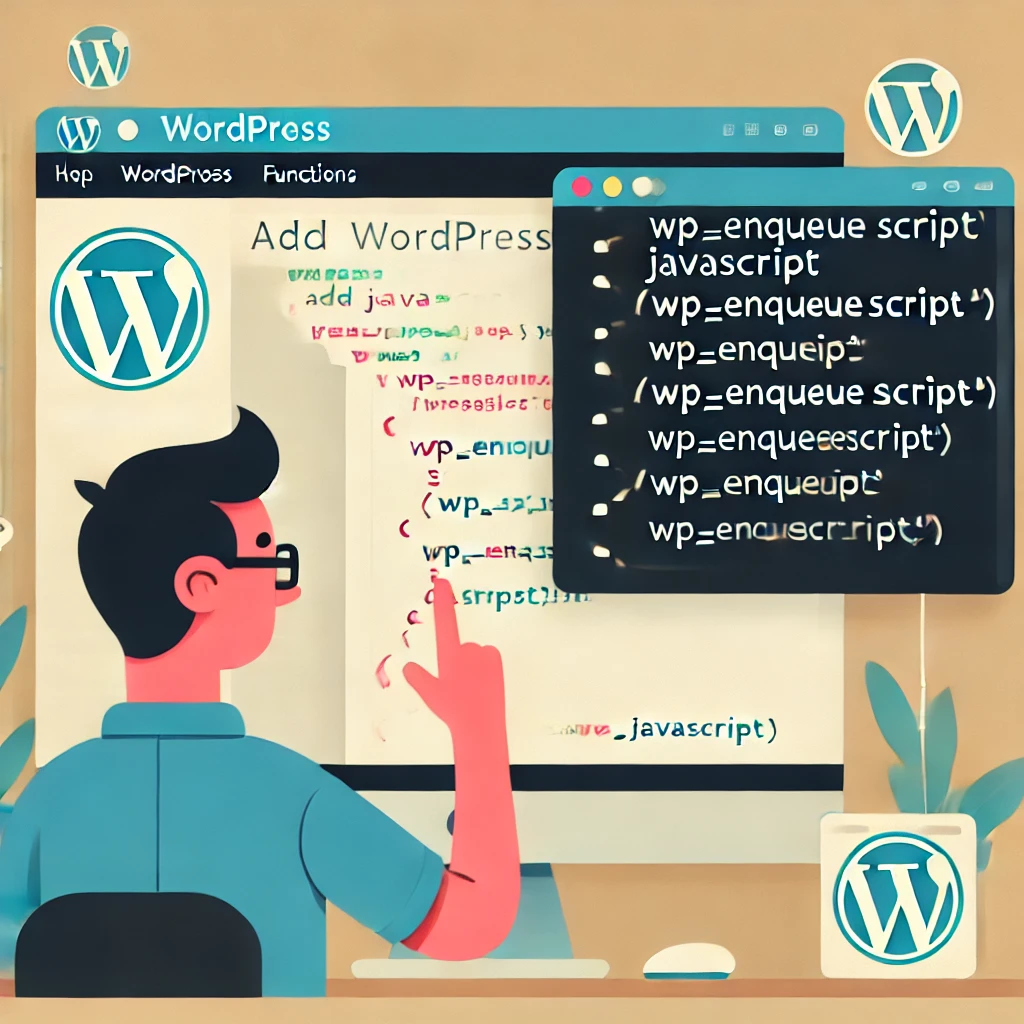
Using WordPress hooks and functions allows you to add JavaScript to specific parts of your site without directly editing theme files.
Using wp_enqueue_script() Function: The wp_enqueue_script() function adds custom JavaScript files to your WordPress theme. Here’s how:
function add_custom_js() {
wp_enqueue_script( 'my-custom-js', get_template_directory_uri() . '/js/custom.js', array(), false, true );
}
add_action( 'wp_enqueue_scripts', 'add_custom_js' );This method ensures that JavaScript files are correctly loaded and don’t conflict with other libraries or themes.
Adding JavaScript to Specific Posts or Pages: You can add JavaScript to only a particular post or page. Use the following code to do this:
function add_custom_js_to_page() {
if ( is_single( '1' ) ) { // Replace '1' with your post or page ID
?>
<script>
// Your JavaScript code here
</script>
<?php
}
}
add_action( 'wp_head', 'add_custom_js_to_page' );Replace 1 with the actual post or page ID, and the JavaScript will be added only to that page.
Example Use Case:
Say you have a special promotion on a specific product page and want to add JavaScript that only affects that page—this method lets you do that.
Summary:
- Pros: Precise control over where the JavaScript runs, prevents code conflicts.
- Cons: Requires familiarity with WordPress hooks, more complex for beginners.
Quick Story: I once needed to add a countdown timer to a single product page during a sale. Using hooks allowed me to add it seamlessly without affecting the rest of the site.
Challenge: Use the wp_enqueue_script() function to add JavaScript to a specific page on your site. Try adding a countdown timer or a custom message to make the page more interactive.
Method 4: Creating a Custom Plugin
If you prefer keeping your JavaScript code independent of your theme, you can create a custom plugin to add JavaScript.

Steps to Create a Custom Plugin:
- In the
wp-content/pluginsdirectory, create a new folder namedmy-javascript-plugin. - Inside this folder, create a new file called
my-javascript-plugin.php. - Add the following plugin header and JavaScript code:
<?php
/*
Plugin Name: My JavaScript Plugin
Plugin URI: http://example.com/
Description: This plugin contains my JavaScript code.
Version: 1.0
Author: Your Name
Author URI: http://example.com/
*/
function add_my_javascript() {
?>
<script>
// Your JavaScript code here
</script>
<?php
}
add_action( 'wp_footer', 'add_my_javascript' );
?>4.Save and upload this file to your server. You should now see your custom plugin listed on the WordPress Plugins page.
5.Activate the plugin, and your JavaScript code will be executed. Example Use Case:
This is ideal when you want a piece of JavaScript functionality that isn’t tied to a specific theme—maybe you want it to persist even if you change your theme later.
Summary:
- Pros: It keeps custom JavaScript separate from the theme, making it more flexible and portable.
- Cons: Requires some plugin development knowledge and more initial setup.
Pro Tip: Creating your plugin may seem daunting, but it’s a great way to make your code reusable across different themes or projects.Challenge: Create a simple custom plugin that adds a “Hello, World!” alert to your site. This is a great way to get familiar with plugin development.
Method 5: Adding JavaScript to Widgets
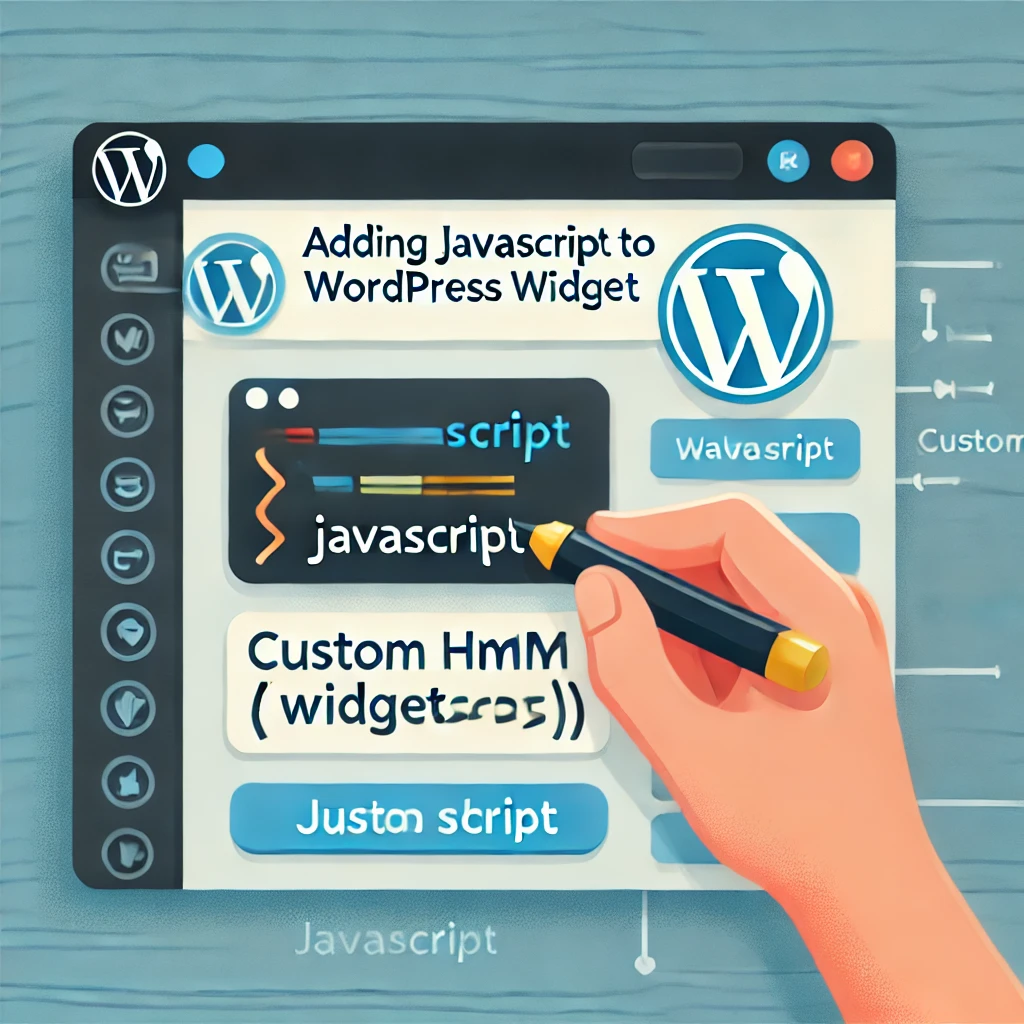
To add JavaScript to a widget, follow these steps:
- Navigate to the Widgets section in your WordPress dashboard.
- Add a Custom HTML widget to your sidebar or footer.
- Insert your JavaScript code using the
<script>tag:
<script>
alert("Hello, this is a widget alert!");
</script>Example Use Case:
Want to add a welcome message or some fun interaction in your sidebar? Adding JavaScript to a widget area is a perfect choice.
Summary:
- Pros: Quick and easy to add JavaScript to specific widget areas.
- Cons: Limited scope, may not be ideal for larger scripts.
Challenge: Add a JavaScript-based welcome message to a widget area on your site. This will allow you to see how widgets work with custom scripts.
Adding JavaScript to the Footer
You can also add JavaScript to the footer of your WordPress site. The easiest way to do this is using the wp_footer hook in your theme's functions.php file.function add_js_to_footer() {
?>
<script>
// Your JavaScript code here
</script>
<?php
}
add_action( 'wp_footer', 'add_js_to_footer' );This ensures the JavaScript is loaded last, which can improve site speed and prevent issues with the Document Object Model (DOM) not being ready.
Example Use Case:
Loading JavaScript in the footer can be very useful for tracking scripts, like Google Analytics, as it ensures they don’t affect the loading speed of your main content.
Summary:
- Pros: Ensures JavaScript loads after the main content, improving performance.
- Cons: It requires coding knowledge and is limited to scripts that should run after page load.
Debugging JavaScript Errors in WordPress
Sometimes, JavaScript may not behave as expected. Here’s how to debug errors in your WordPress site:
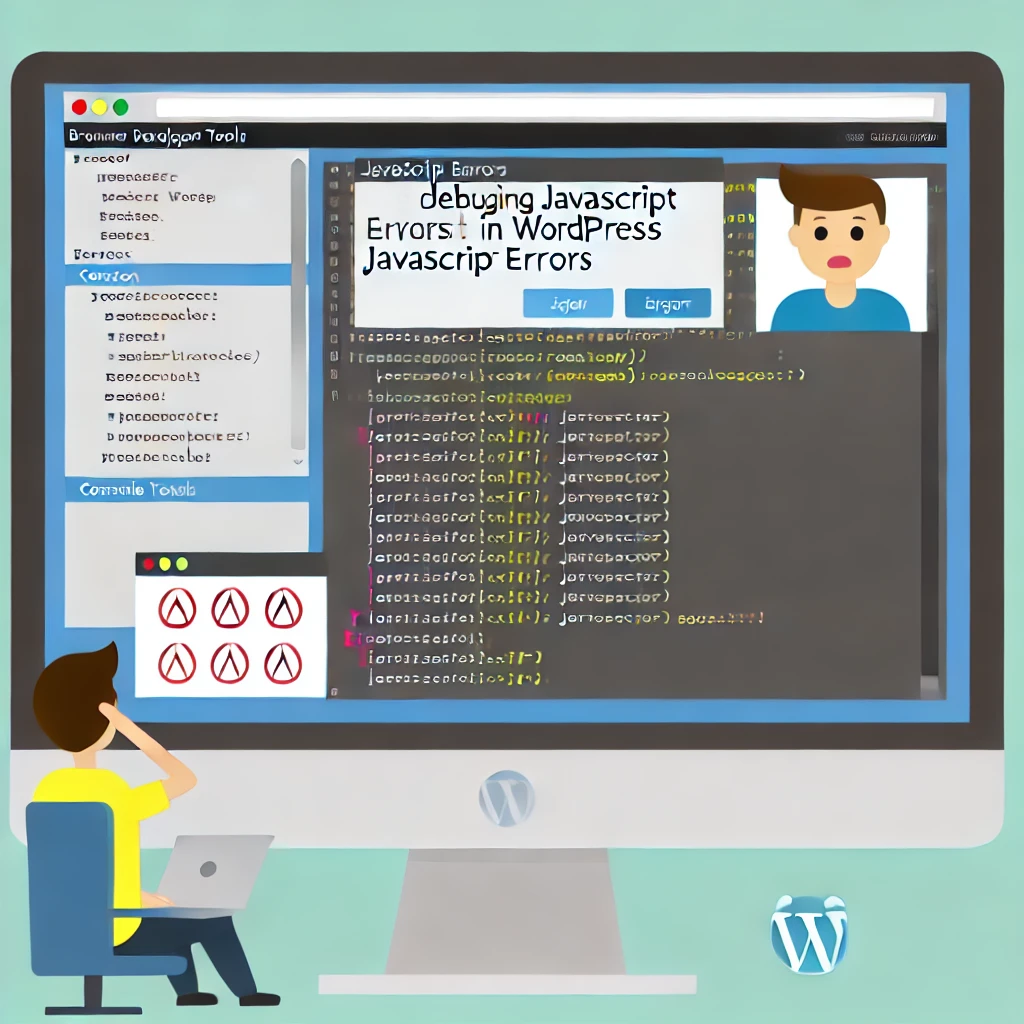
1.Use the Browser Console: Right-click anywhere on your webpage, select Inspect, and then go to the Console tab. Here, you’ll see any JavaScript errors listed.
- Example Error:
Uncaught ReferenceError: myFunction is not defined. This means the function is either missing or incorrectly named.
2.Enable Script Debugging: To enable debugging for JavaScript in WordPress, add the following line to your wp-config.php file:
define('SCRIPT_DEBUG', true);3.Disable Plugins: If your JavaScript isn’t working as expected, disable all plugins to see if one is causing a conflict. Then, reactivate them one by one to find the culprit.
- Example Scenario: A plugin may override your JavaScript function, causing unexpected behavior.
4.Common Errors:
- Syntax Errors: Check your JavaScript code for missing semicolons, unmatched braces, or typos.
- Incorrect File Paths: Ensure the path to your JavaScript file is correct, especially when using wp_enqueue_script().
- Loading Order Issues: JavaScript, which depends on elements not yet available in the DOM, should be wrapped inside a DOMContentLoaded or window—onload event.
document.addEventListener('DOMContentLoaded', function() {
// Your code here
});Real-Life Example: I once spent hours debugging an issue, only to realize I forgot to wrap my script in a DOMContentLoaded event, causing it to run before the needed elements were loaded. Lesson learned!
Tools and Resources
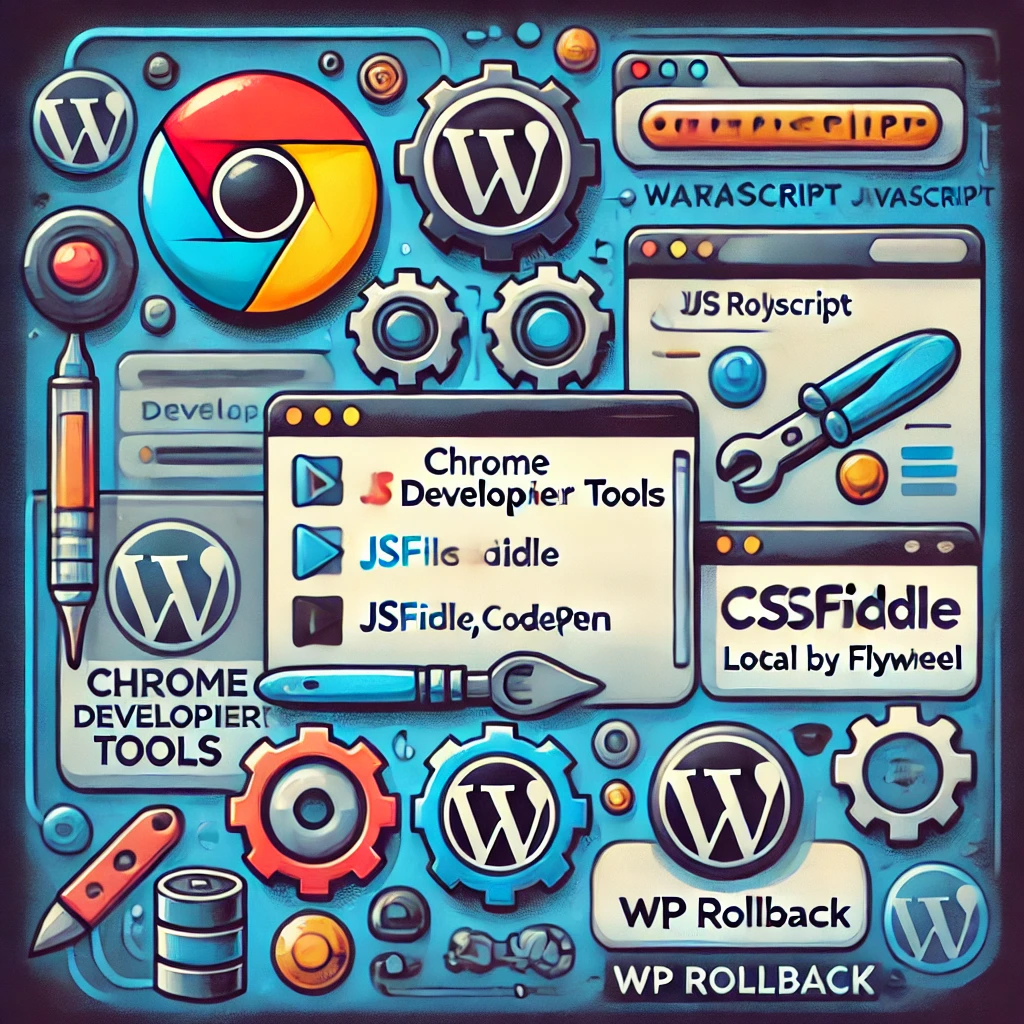
Here are some tools and resources that can help you while working with JavaScript in WordPress:
- Chrome Developer Tools: Great for inspecting elements and debugging JavaScript code directly in the browser.
- JSFiddle / CodePen: Use these online playgrounds to test small bits of JavaScript code before adding them to your site.
- Local by Flywheel: A tool to create a local WordPress environment where you can test JavaScript safely.
- WP Rollback: If a plugin update breaks your JavaScript, you can use WP Rollback to revert to an earlier version.
Quick Tip: Use tools like JSFiddle to quickly experiment with JavaScript. It saves you from potentially breaking your WordPress site during testing.
Common Questions (FAQ)
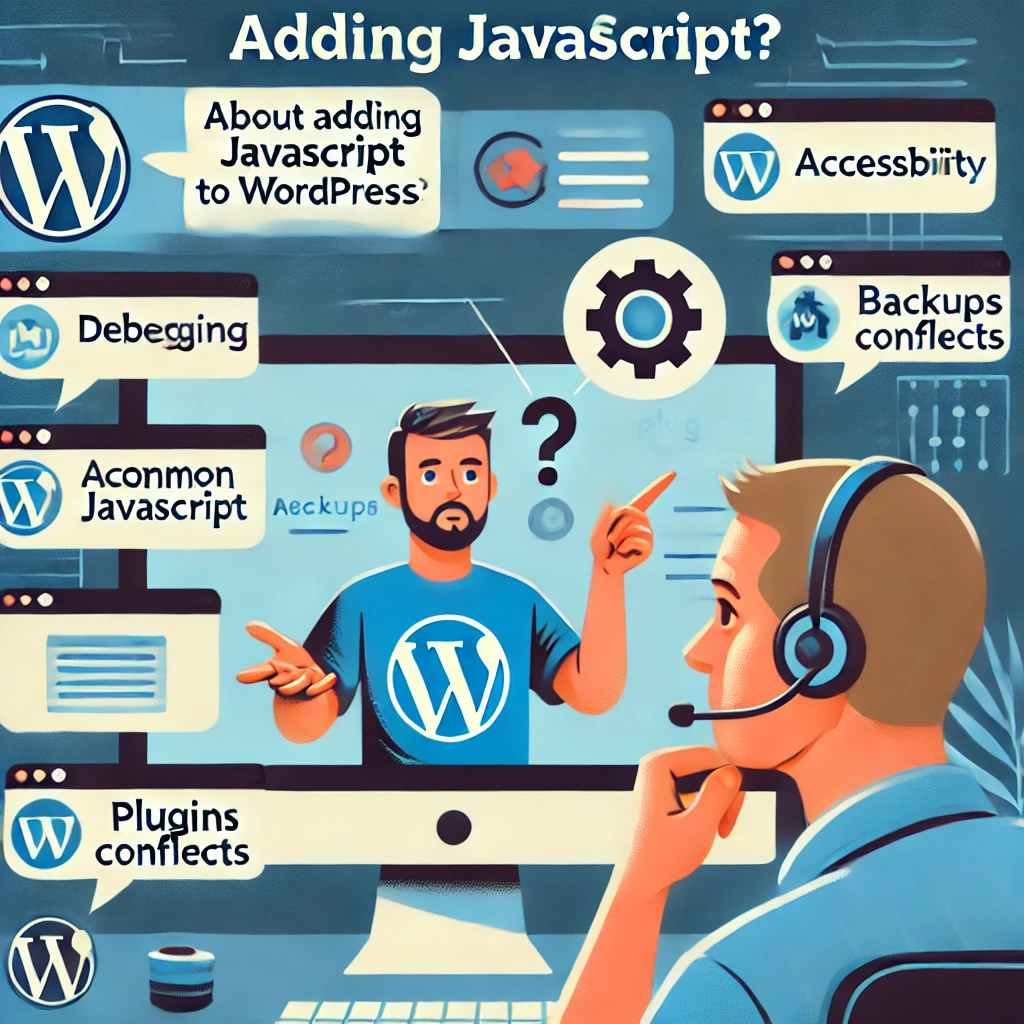
1. Can I add JavaScript to specific pages only?
You can use WordPress hooks and conditional tags to add JavaScript to specific pages. For example, is_single() can target individual posts.
2. What if my JavaScript breaks my site?
Always use a backup before adding custom code. You can restore your site to a working state if an error occurs.
3. Why isn’t my JavaScript working?
Check the browser console for errors, ensure the script is loaded correctly, and verify no conflicts with other plugins or themes.
4. How do I make sure my JavaScript doesn’t affect accessibility?
Ensure JavaScript interactions are keyboard accessible and provide alternatives for screen readers. Avoid using JavaScript, which disrupts the normal page flow.
Conclusion

Summary Table:
| Method | Pros | Cons |
|---|---|---|
| Plugin | Easy, no coding required | Limited flexibility, potential conflicts |
| Theme Files | Full control, easy integration | Risky during theme updates |
| Hooks and Functions | Precise control, less conflict-prone | Requires coding knowledge |
| Custom Plugin | Independent from theme, flexible | Requires plugin development knowledge |







Responses